

EGFP (30 mM) was subjected to a sequence of 10 “bleach” iterations over the ROI (1.8 seconds) followed by image acquisition using 488 and 561 nm illumination. ( d) Time course of the increase in red fluorescence with successive 405 nm irradiations within the region of interest (ROI). ( c) Absorption spectra of EGFP (~2 μM) at pH 5.0 and pH 8.0. ( b) Emission spectra of photoconverted red state EGFP acquired using the Zeiss 710 spectral detector (5 nm bandwidth intervals). 10 iterations of 257 ms each were performed.
#PHOTOCONVERT SOFTWARE#
( a) Typical pre- and post-photoconversion images of a thin (~10 μm) layer of 30 μM EGFP using 405 nm excitation delivered through a 1.2 NA objective to the region within the circle using the Zen software bleaching mode (Green channel: 505–525 nm Red channel: 580–670 nm scale bar: 50 μm). Photoconversion of purified EGFP in vitro. We show its effectiveness in plant, mammalian and Drosophila cells. We report here a method that can be used to convert GFP from green to red without a special environment or exogenous chemicals.

Performing GFP photoconversion in low oxygen requires placing the tissue in special conditions and use of oxidizers obviates one of the advantages of GFP-the ability to image without concerns about uptake of additional chemicals. The addition of electron acceptors such as BQ resulted in 600 nm emissions with the exception of one report of a 675 nm peak 17. The “red” emission maximum was at 560 nm in the FAD-mediated conversion 15, while three peaks were reported (560, 590 and 600 nm) under anaerobic conditions (no added FAD) 14. The fluorescence spectra of the photoconverted species varied depending on the conditions used to catalyze the conversion. Because many proteins have already been tagged with EGFP or GFP modified by an S65T mutation, being able to photoconvert these common forms of GFP would allow the use of existing transgenic lines for studies of dynamic changes.ĮGFP has been known to change color after 488 nm illumination under low oxygen conditions 14, low oxygen with added FAD 15 or by added oxidizing agents such as potassium ferricyanide, benzylquinone (BQ) or MTT 16. For example, various transgenic mouse lines ( ) have been produced with GFP labels on proteins 13 retransforming such lines with genes encoding new photoconvertible proteins would require considerable time and expense. In addition to specific collections, many investigators with interests in particular proteins or subcellular locations have produced cell lines or organisms with GFP tags. In Arabidopsis, lines are available with GFP tags on transcription factors 11, with GFP as promoter-reporters 11 and with GFP labels on subcellular structures 12. In Drosophila, there is a collection ( ) in which GFP has tagged full-length endogenous proteins expressed from their endogenous loci or used in an enhancer trap 9, 10. For example, a collection of strains ( ) expressing full-length GFP-tagged proteins is available for yeast 7, 8. However, a number of collections of GFP-tagged organisms had been made before these proteins became available for use. The development of photoconvertible fluorescent proteins such as mEosFP, tdEosFP, Dendra, Dronpa, Kaede, KikGR, mOrange allows new questions to be asked concerning dynamic processes in living cells 1, 2, 3, 4, 5, 6.

While genes encoding fluorescent proteins specifically designed for photoconversion will usually be advantageous when creating new transgenic lines, our method for photoconversion of GFP allows the use of existing GFP-tagged transgenic lines for studies of dynamic processes in living cells.įusions of Green Fluorescent Protein (GFP) and its derivatives are extremely valuable tools for examining gene expression, protein and RNA localization, protein-protein interactions, protein synthesis and degradation and organelle movement. We demonstrate its use in transgenic plant, Drosophila and mammalian cells in vivo. Here we describe a fast, localized and non-invasive method for GFP photoconversion from green to red. However, before genes encoding these fluorescent proteins were available, many proteins have already been labelled with GFP in transgenic cells a number of model organisms feature collections of GFP-tagged lines and organisms. Such proteins are finding application in following the dynamics of particular proteins or labelled organelles within the cell. A variety of fluorescent proteins have been identified that undergo shifts in spectral emission properties over time or once they are irradiated by ultraviolet or blue light.


 0 kommentar(er)
0 kommentar(er)
